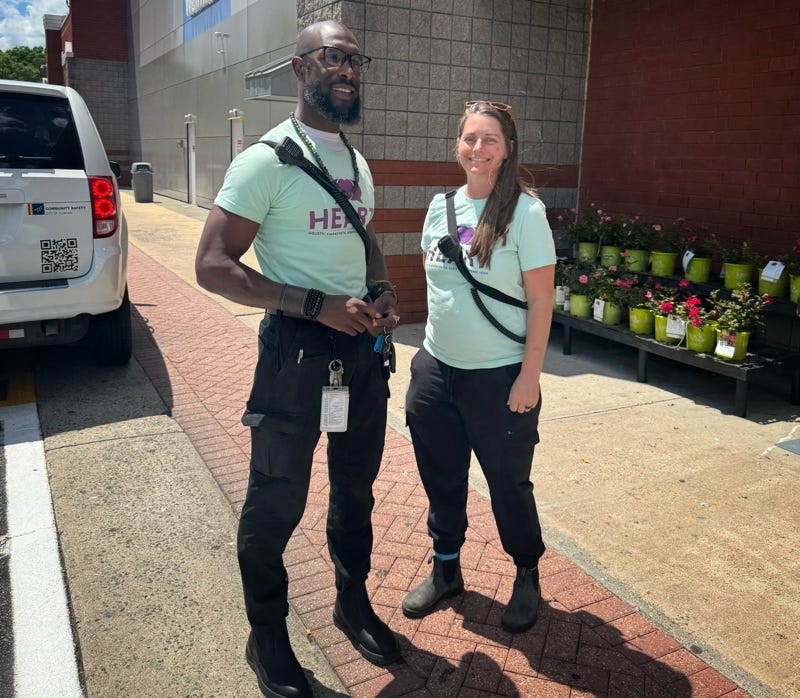Durham’s HEART provides a calming crisis response
I shadowed a crisis response team. Here’s one story
“He just didn't trust that we, in our teal shirts with the heart on it, could command a level of respect” Rashid Lyon, a mental health clinician with HEART, said in his calm, kind voice.
HEART is a clever acronym (Holistic Empathetic Assistance Response Teams) for the 911-dispatched teams of mental health clinicians, medics and peer support specialists in Durham, North Carolina. Rashid Lyon, who goes by Rah, worked in a close knit team with Stephanie Pleasants, a peer support specialist, and Patrick Fahy, a medic.
When the team got their radio dispatch, they learned the basic details: it was a workplace conflict in which a manager told a mechanic he was suspending him for refusing to turn off his loud music, and the mechanic, the manager said, refused to leave. I was startled that this incident had escalated into a 911 call.
When the team arrived, the manager was adamant that the police come instead. He did not intend disrespect, he said. But he wanted the police, not HEART, because he wanted the mechanic to be forced to leave. The manager was frustrated that mechanic kept working, kept ignoring him.
Could the mechanic return to work later, Stephanie asked, trying to gather the details. Yes, he was suspended for a week.
Stephanie asked the manager to just let them try. Later, when I asked her what she hoped would happen, she said it this way:
“I was thinking about how we could get from that moment to the next moment.”
This is in many ways the job that HEART and other alternative response teams around the nation do: they try to help people move from one moment to the next moment, without any moment spiraling into a greater crisis.
The structure of a story often involves a conflict that can spike into a climax, as some of us learn in a literature class.” Sometimes this is depicted by a line graph that spikes and then collapses to show a resolution.
The HEART team is out to steady that line so it doesn’t spike. They don't want people to face further strife or increased suffering. The story, hopefully, can instead flatten into simply a series of moments without drama.
By calling the police, the manager sought a dramatic resolution, and he was doubtful about these responders in their teal t-shirts that, as Rah observed, depicted a heart, and not a badge, and words on the back that read “compassionate care response.”
Though he clung onto his conviction that the police would be the best responder, he finally agreed to let them try.
The team approached the mechanic at his work-bay near the far end of a voluminous warehouse full of cars and parts.
The mechanic immediately agreed to leave, but he wanted them to hear his story, too. Rah and Stephanie walked with him to his car.
Patrick held back in the warehouse with the manager, not crowding the mechanic in his car where Stephanie and Rah now chatted with him. I thought about how crowding a person can raise their stress, and that police training often requires many officers to tour over one distressed person to assert dominance and control a situation.
Rah and Stephanie and Patrick weren’t trying to dominate anyone.
I thought about how a person might call the police when they helpless in their own efficacy and want a threat of force — locks, bars and violence — backing them up.
The manager told Patrick he’d been working there for months while the mechanic had been there for years.
“We always get the last layer,” Patrick told me later, and that last, most recent layer came via a person who called 911 and the notes provided by the dispatcher.
Because HEART could take their time, they could remain curious to the other layers, and let people vent.
The mechanic vented his frustrations to Rah and Stephanie: how the music helped him work — it could get him into a certain groove, a certain space. They brainstormed with him — could he, for instance, wear earbuds? Seemingly satisfied that he’d been heard, the mechanic drove away.
I meant no disrespect, the manager said, over and over, continuing to describe how upset he was that the mechanic did not respect his authority.
Later, back at City Hall, Stephanie catalogued more details she noticed that informed her approach: the workforce was not particularly diverse, she pointed out. The mechanic was Latino and most of the others we walked by appeared white.
She also heard someone else loudly playing their music as they worked at a different bay, but it was country music, while the mechanic in trouble was playing hiphop. This made her wonder about cultural differences.
She also noticed how, even though the mechanic was suspended and driving away, other employees ran after him with questions about the remaining cars. He had knowledge and commanded a certain respect, she noticed.
Ultimately, by listening and noticing, the HEART team made sure that one tense moment transitioned into a calmer one. Things did not get worse, and might have even gotten a little bit better.






This description of Heart’s de-escalation demonstrated that active listening and setting boundaries can help resolve tense situations. The boss who agreed to let Heart try to defuse the situation deserves praise. He represents how we can become better at living and working in our communities if we are willing to try innovations that encompass principles of human behavior, respect, and response.
Great story, thanks for putting it out here.